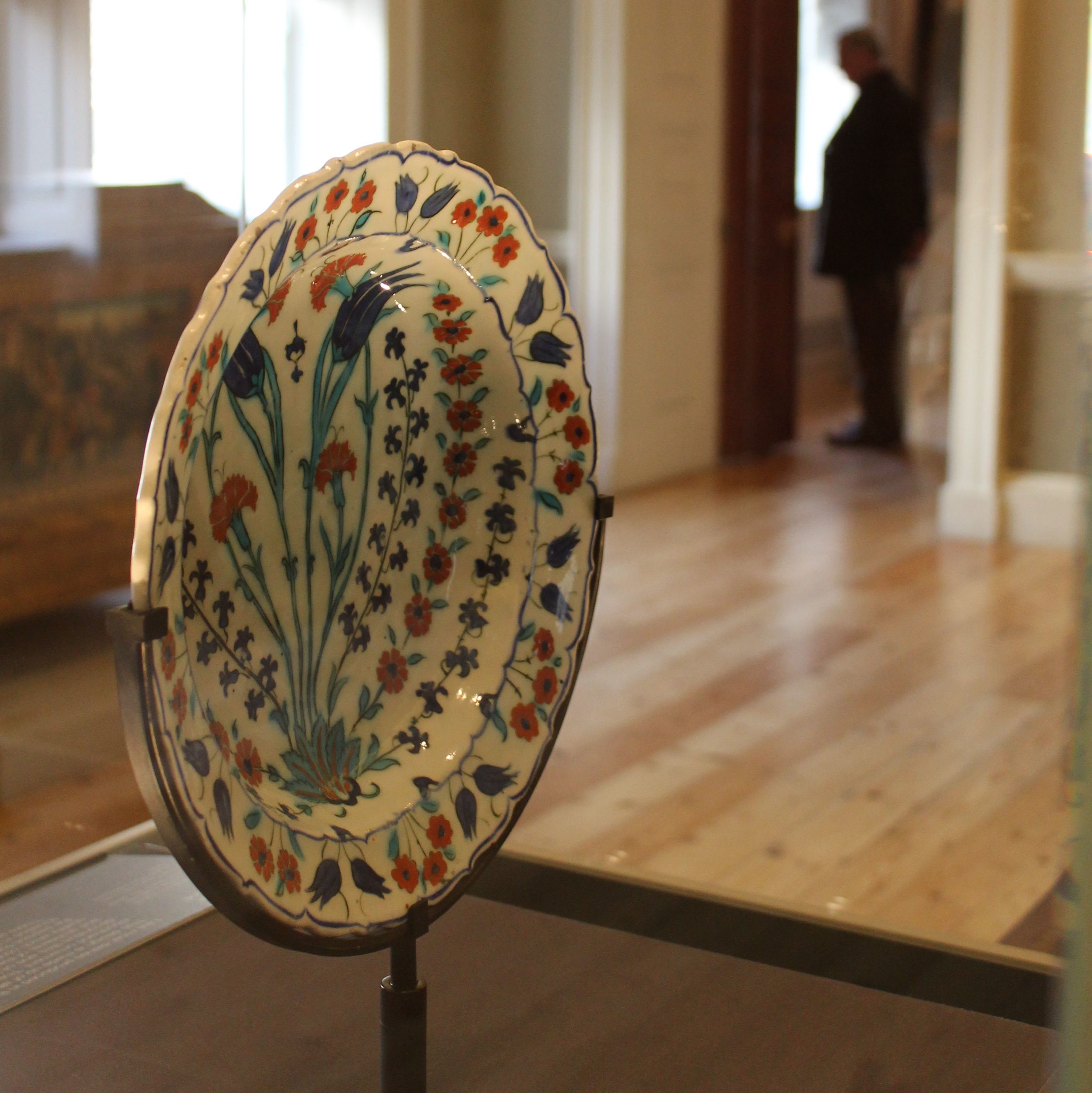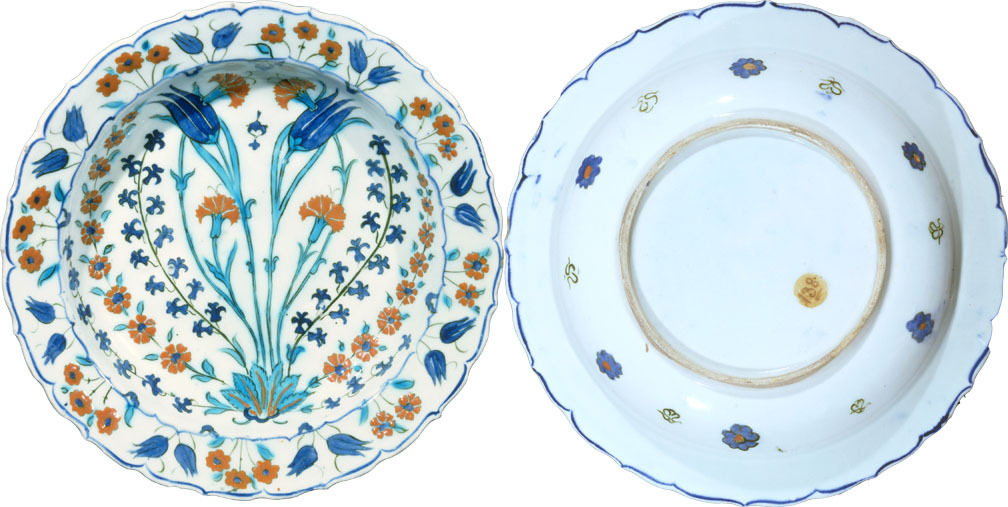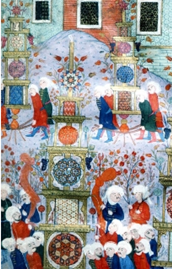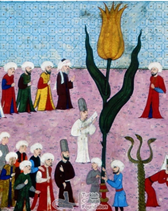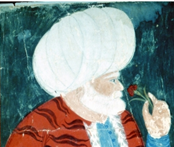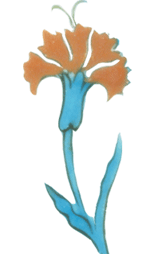Floral motifs can adorn anything from towering cultural monuments to your grandmother’s pin cushion. And so, we might overlook the significance of the humble bloom. Laila El-Sayed, however, shows us the powerful cultural roots of a floral dish from The Courtauld Gallery. Produced between 1560–65 in the Ottoman city of Iznik (North-West Anatolia), the dish is ripe for interpretations inspired by 16th-century lyrical poetry, travel narratives and mystical meditations. Read on to learn about its remarkably symmetrical arrangement of carnations and blossoms, tulips and hyacinths.
Work on this project was carried out during Laila’s Masters in History at the University of Kent in Canterbury.
Interpreting Iznik floral motifs
 This beautifully ornate dish was bequeathed to The Courtauld Gallery in 1966. The floral motifs of the object typify the Kara Memi floral style, named after the chief painter (fl.1545-66) of Süleyman the Magnificent’s (1494–1566) court. This floral style was an artistic move towards realism in depicting garden flowers. It is also often called the ‘Quatre Fleurs’ style because it used four principal flowers: the tulip, carnation, rose and hyacinth.
This beautifully ornate dish was bequeathed to The Courtauld Gallery in 1966. The floral motifs of the object typify the Kara Memi floral style, named after the chief painter (fl.1545-66) of Süleyman the Magnificent’s (1494–1566) court. This floral style was an artistic move towards realism in depicting garden flowers. It is also often called the ‘Quatre Fleurs’ style because it used four principal flowers: the tulip, carnation, rose and hyacinth.
The dish has many references that make it not only an object of great beauty but also a complex cultural document. For the scholars Atasoy and Raby: ‘the popularity of the [Kara Memi floral] style might be attributed to symbolism’.[1]
The floral patterns on The Courtauld Iznik dish could give rise to stereotypes about the merely decorative quality of Islamic floral art. Because of the debate within Islam regarding the status of figurative imagery, and the view of some that Islam should be intolerant of figurative representation, the merely decorative use of flowers has been argued for.
However, this conception is misleading when employed to interpret 16th-century Ottoman art.[2] The floral motifs were used on Ottoman prayer books, Qur’an frontispieces, tobacco pouches, kaftans, imperial tents, and decorative mattress covers. The presence of flowers on all kinds of objects could suggest that floral motifs transcended their merely decorative function to reflect spiritual, cultural and literary connotations.
Ottoman Gardens Through European Eyes
The floral genre of Iznik ceramics fascinated 16th-century European travellers. Their comments on the meaning of flowers and gardens in Ottoman culture can help us to understand why Iznik artisans favoured floral motifs.
To many European travellers, Ottoman floriculture was a newsworthy novelty. Pierre Belon du Mans (1517–64), a herbalist who travelled in quest of plants throughout the Ottoman empire between 1546–49 in the entourage of the French ambassador to Süleyman the Magnificent, noted that:
There are no people who so much delight in beautiful flowers as the Turks, when they find a beautiful wallflower or some other graceful flower, even though it has no smell they do not prize it the less. We like to have bunches of different kinds of scented flowers mixed together, but the Turks care only for sight rather than smell, and like to have only one flower at a time. Even if they may have several different kinds of flowers it is their custom to wear only a single flower in the folds of their turban. Artisans commonly have several flowers of different colours in a jar of water in front of them, to keep them fresh in their beauty. And so the Turks think as much of their gardens as we do, and go to great trouble to get exotic trees, particularly those that have beautiful flowers, and grudge no money for the purpose.[3]
Belon communicated the Ottomans’ delicate tastes and passion for ‘beautiful flowers [which] are held in high esteem’. Istanbul in the 16th century, according to Belon, was an international marketplace for knowledgeable horticulturists, where ‘so many foreigners who come to Constantinople in ships from other countries bring with them roots of plants which have beautiful flowers and sell them in the markets, and from all the things that they bring they make money’.
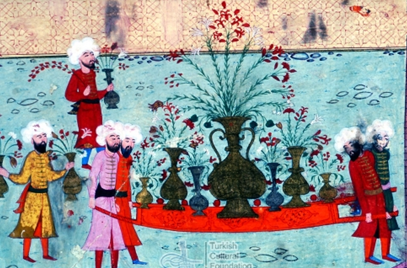
Surname-ì Humayün [The book of Imperial festivities], written by famous court annalist Seyyid Lokman and Illustrated by Nakkaş Osman, 1582.
Ottoman floriculture received further attention from Ogier Ghiselin de Busbecq (1522–92), a Flemish diplomat who resided in the Ottoman lands from 1555–62).[4]
On his journey from Adrianople to Constantinople, de Busbecq wrote in his letters, ‘we everywhere came across quantities of flowers—narcissi, hyacinths and tulipans, as the Turks call them. We were surprised to find them flowering in mid-winter, scarcely a favourable season.’ Busbecq also observed that the Ottoman ‘do not allow rose-leaves to lie on the ground, because they think that the rose sprang from the sweat of Mahomet, just as the ancients believed that it came from the blood of venus’.
The Quatre Fleurs
Within 16th-century Ottoman culture, gardens were both spiritual and intellectual spaces. Gardens were places for the religious scholars (meclis-i ulema) to study and contemplate the marvels of Allah the Creator. Flowers evoked Qur’anic descriptions of Paradise and the garden of Eden.[5] Also, gardens were spaces for cultured companionship (sohbet) between courtiers and intellectuals.[6]
Outdoor social gatherings were fundamental to Ottoman society as a whole, and a central activity in the culture of the educated elite.[7] 16th-century Ottoman miniatures exhibit gardens as ideal spaces for all sorts of social gatherings: dinners, holiday festivities, circumcision feasts and weddings.
Whoever wants a party in the rose garden
let him have private sohbet
With a beloved whose hair is a hyacinth
whose face is a rose, lips a bud
Revani (d. 1524)
The Tulip (lâle)
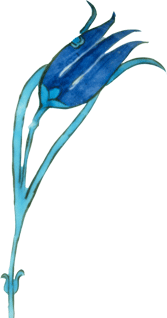 On The Courtauld’s dish, the pair of tulips is the obvious focal point. This resonates with the mystic (Sufi) perception of the ‘centred’ divine manifestation. Within Ottoman culture, the tulip had a special symbolic importance and was regarded as the holiest of all the flowers.
On The Courtauld’s dish, the pair of tulips is the obvious focal point. This resonates with the mystic (Sufi) perception of the ‘centred’ divine manifestation. Within Ottoman culture, the tulip had a special symbolic importance and was regarded as the holiest of all the flowers.
The Ottomans embroidered tulips onto underclothes, as amulets, to guard themselves against danger, harm or misfortune. It was the flower of God because the letters used in the Ottoman word for tulip (لال) are the letters used to write the name of God (الله). The tulip also represented the virtue of modesty before God because, when in full bloom, it bows its head.[8]
For the romantic poets, the tulip represented the cheek of the beloved:
Those tulip-cheeked girls, what they dared do
in the garden!
Beside them, the cypress could not sway,
nor the rosebuds open
Nejati (d. 1509)
Carnations (karanfil)
Because of its extended blooming period, the carnation (Karanfil) was thought to be a symbol of the power and renewal of life. On The Courtauld Gallery’s dish, the carnation, the symbol of life, twines around and embraces the tulip, the symbol of the ‘divine’ or the source of life. Based on the many Ottoman Sultans and admirals portrayed while holding a carnation, it is tempting to speculate that the carnations retained their political meaning.
Hyacinth (sümbül)
 The hyacinth in the 16th-century Ottoman love lyric, or gazel, has been interpreted as a metaphor for the beloved’s curls.[9]
The hyacinth in the 16th-century Ottoman love lyric, or gazel, has been interpreted as a metaphor for the beloved’s curls.[9]
What do you say about that Hyacinth curl,
along with those cheeks of rose?
Revani (d. 1524)
Hazrat Mevlana Rumi (1207–73), the founder of the Ottoman Mevlevi Sufi order, used the hyacinth to praise Prophet Muhammad (PBUH) in one of his lyrics, the Na’t. The ‘exalted’ hyacinth acquired a special status among the flowers representing the Prophet, and thus the poet or artist’s sincerity in loving the Prophet:
Oh the Beloved of Allah! You are the Prophet of the Mighty Creator
You are pure and peerless amongst the servants of Allah.
The cypress of the Prophets’ Garden, You are the spring of the world of insight
You are the rose of the Sharia Garden, the Exalted Hyacinth!
Hazrat Mevlana Rumi (c. 1258)
Plum Blossom (karayemiş)
 The flowering plum blossoms (or prunus), the outermost floral spray on the displayed dish, was a common motif in the Kara Memi style.
The flowering plum blossoms (or prunus), the outermost floral spray on the displayed dish, was a common motif in the Kara Memi style.
The prunus was used on the tiles of entrances to the tombs of Sultan Suleyman’s wife Hasseki Hürram and the grand vizier Rüstem Pașa. The prunus is also used to decorate the mihrabs and minbars of several mosques such as those of Hasseki Hürram, Sultan Selim and Sokollu Mehmet Pașa. Its conventional decorative usage suggests it was intended to convey the lush green bounty of Paradise.[10] On the dish, the prunus or plum blossom might then complement the mystical Sufi theme, in that, as the symbol of bounty, it encompasses all the other flowers within its perimeter.
The Whirling Flowers
The symmetrical floral composition on the dish is one of the most marked features of a number of Iznik plates of the period between 1550–65. From a purely doctrinal viewpoint, the aesthetics of symmetry derive from the Islamic notion of cosmic balance (mizan) and the harmony of the Creation, as represented in several passages of the Qur’an:
And the heaven He raised and imposed the balance, That you not transgress within the balance. And establish weight in justice and do not make deficient the balance.
(Qur’an, Surat Ar-Raĥmān [The Beneficent], verses 5–9)
The symmetrical floral composition on The Courtauld’s Iznik dish has a striking dynamic movement, whereby the flowers are encircling the tulip. The rhythmic floral circles project the Sufi ‘whirling’ dance, a hallmark of the Ottoman Mawlawıya Sufi order, which was prevalent in the 16th century.
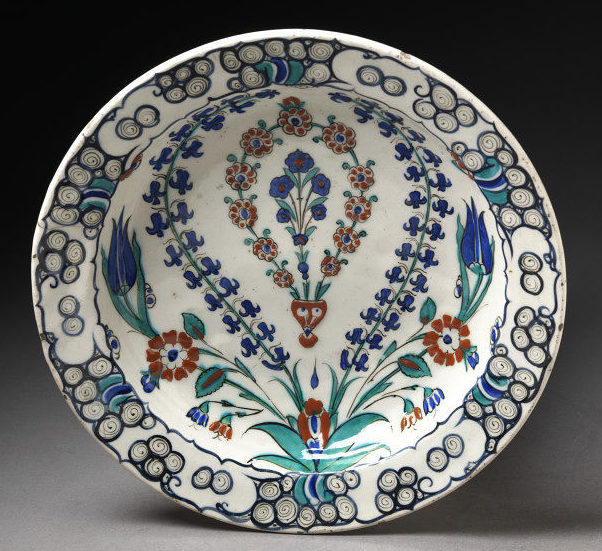
It has been suggested that Iznik craftsmen were members of Sufi orders, and that Dervish lodges and saints’ mausoleums were probably centres of religious practice and sociability for many artisans.[11]
The Sufi tradition prefers orderly, symmetrical arrangements in general, and purely circular forms in particular. The circle (da’ira, halaqa) is sacred and the circular motion connects to the world of the spirit. Circles are seen as a symbolic imitation of pilgrims orbiting the Ka’aba in Mecca, and the planets orbiting the sun.
Using methods of textual analysis, it is possible to interpret the floral composition of the dish in terms of Sufi spirituality. In this vein, the composition echoes the whirling Sufi dance, which ‘involves some form of circle formation with oscillating, swaying movement, around, into and out of the circle. Occasionally an individual participant will step into the middle of the circle […] and performs his whirling in the middle while the members of the host group form concentric circles around him.’[12] The whirling flowers are perpetually dancing in mystical circles, ever inwards, until a deep peace may be felt to be centred upon the tulip, the symbol of divinity.
Acknowledgements
Prof. Donna Landry, University of Kent;
Prof. Mehmet Kalpakli, Department of History, Bilkent University, Turkey
References
[1] Nurhan Atasoy and Julian Raby, Iznik: The Pottery of Ottoman Turkey (London: Alexandria Press, 1989), 223.
[2] David James, Islamic Art: An Introduction (London: The Hamlyn Publishing Group, 1974), 56–76.
[3] Pierre Belon du Mans, Travels in the Levant: The Observations of Pierre Belon du Mans (1553), ed. Alexandra Merle, trans. James Hogarth (UK: Harding Simpole, 2012), Chapter 51, 469.
[4] Ogier Ghiselin de Busbecq, The Life and Letters of Ogier Ghiselin de Busbecq, ed. trans. Charles Thornton Foster and F.H. Blackburne Daniell (New York: Cambridge University Press, 2012), Vol. 1, Letter I, 107—10.
[5] Mikhail B. Piotrovsky, Art of Islam: Heavenly Art, Earthly Beauty, ed. John Vrieze (Amsterdam: Lund Humphries Publishers, 2000).
[6] Walter G. Andrews and Mehmet Kalpakli, The Age of the Beloved: Love and the beloved in early modern Ottoman and European culture and society (Durham: Duke University Press Books, 2005), 106.
[7] Gábor Ágoston and Bruce Alan Masters, Encyclopedia of the Ottoman Empire (New York: Infobase publishing, 2010), 272.
[8] Walter G. Andrews, Najaat Black and Mehmet Kalpakli, Ottoman Lyric Poetry: An Anthology (Seattle: University of Washington Press, 2006), 107.
[9] Nurhan Atasoy and Julian Raby, Iznik: The Pottery of Ottoman Turkey (London: Alexandria Press, 1989), 223.
[10] Walter G. Andrews, ‘Gardens—Real and Imagined—in the Social Ecology of Early Modern Ottoman Culture’, in Garden Imagination: Historical Forms and Cultural Roles; Dumbarton Oaks Colloquium Series in the History of Landscape Architecture, ed. Michel Conan, 91–116 (Georgetown: Dumbarton Oaks Publications, 2008).
[11] Suraiya Faroqhi, Artisans of Empire: Crafts and Craftspeople Under the Ottomans (London: I.B.Tauris & Co. Ltd., 2009).
[12] John Renard, The A to Z of Sufism (Plymouth: The Scarecrow Press, Inc., 2009), 68.

